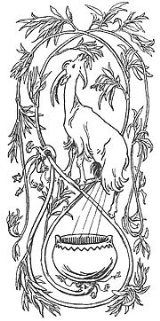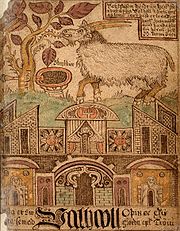
Heiðrún
Encyclopedia


Goat
The domestic goat is a subspecies of goat domesticated from the wild goat of southwest Asia and Eastern Europe. The goat is a member of the Bovidae family and is closely related to the sheep as both are in the goat-antelope subfamily Caprinae. There are over three hundred distinct breeds of...
in Norse mythology
Norse mythology
Norse mythology, a subset of Germanic mythology, is the overall term for the myths, legends and beliefs about supernatural beings of Norse pagans. It flourished prior to the Christianization of Scandinavia, during the Early Middle Ages, and passed into Nordic folklore, with some aspects surviving...
, which consumes the foliage of the tree Læraðr
Læraðr
Læraðr is a tree in Norse mythology, often identified with Yggdrasill. It stands at the top of the Valhöll. Two animals, the goat Heiðrún and the hart Eikþyrnir, graze its foliage.-Etymology:...
and produces mead
Mead
Mead , also called honey wine, is an alcoholic beverage that is produced by fermenting a solution of honey and water. It may also be produced by fermenting a solution of water and honey with grain mash, which is strained immediately after fermentation...
for the einherjar
Einherjar
In Norse mythology, the einherjar are those that have died in battle and are brought to Valhalla by valkyries. In Valhalla, the einherjar eat their fill of the nightly-resurrecting beast Sæhrímnir, and are brought their fill of mead by valkyries...
. She is described in the Poetic Edda
Poetic Edda
The Poetic Edda is a collection of Old Norse poems primarily preserved in the Icelandic mediaeval manuscript Codex Regius. Along with Snorri Sturluson's Prose Edda, the Poetic Edda is the most important extant source on Norse mythology and Germanic heroic legends, and from the early 19th century...
and Prose Edda
Prose Edda
The Prose Edda, also known as the Younger Edda, Snorri's Edda or simply Edda, is an Icelandic collection of four sections interspersed with excerpts from earlier skaldic and Eddic poetry containing tales from Nordic mythology...
.
Prose Edda
Geit sú er Heiðrún heitir stendr uppi á Valhöll ok bítr barr af limum trés þess er mjök er nafnfrægt, er Léraðr heitir, en ór spenum hennar rennr mjöðr sá er hon fyllir skapker hvern dag. Þat er svá mikit at allir einherjar verða fulldruknir af. - http://www.hi.is/~eybjorn/gg/gg4par38.html |
A goat called Heiðrún stands up [on its hind-legs] in Valhalla Valhalla In Norse mythology, Valhalla is a majestic, enormous hall located in Asgard, ruled over by the god Odin. Chosen by Odin, half of those that die in combat travel to Valhalla upon death, led by valkyries, while the other half go to the goddess Freyja's field Fólkvangr... biting the buds off the branches of that very famous tree which is called Lærað. From her teats runs the mead with which every day she fills a cauldron, which is so big that all the Einherjar can drink their fill from it. - Young's translation |
Poetic Edda
In the Poetic EddaPoetic Edda
The Poetic Edda is a collection of Old Norse poems primarily preserved in the Icelandic mediaeval manuscript Codex Regius. Along with Snorri Sturluson's Prose Edda, the Poetic Edda is the most important extant source on Norse mythology and Germanic heroic legends, and from the early 19th century...
Heiðrún is mentioned twice. She is described in the Grímnismál
Grímnismál
Grímnismál is one of the mythological poems of the Poetic Edda. It is preserved in the Codex Regius manuscript and the AM 748 I 4to fragment. It is spoken through the voice of Grímnir, one of the many guises of the god Odin, who is tortured by King Geirröth...
in a way similar to Snorri's description.
|
|
Since Snorri quotes other strophes of Grímnismál it seems reasonable to assume that he knew this strophe too and used it as his source for his description of Heiðrún.
In the Hyndluljóð
Hyndluljóð
Hyndluljóð or Lay of Hyndla is an Old Norse poem often considered a part of the Poetic Edda. It is preserved in its entirety only in Flateyjarbók but some stanzas are also quoted in the Prose Edda where they are said to come from Völuspá hin skamma.In the poem, the goddess Freyja meets the völva...
the giantess Hyndla (lit. bitch/she-dog) used the term "Heiðrún" to insult the goddess Freyja. Thorpe and some other translators translated the name straight to "she-goat".
|
OTH OTH may refer to:*On The Hour, British radio comedy series*One Tree Hill , a teenage drama on the CW network in the U.S.*Optical Transport Hierarchy, in telecommunications*Other than honorable discharge, a type of military discharge... didst thou run, |
Heiðrún's name is sometimes anglicized
Old Norse orthography
The orthography of the Old Norse language was diverse, being written in both Runic and Latin alphabets, with many spelling conventions, variant letterforms, and unique letters and signs. In modern times, scholars established a standardized spelling for the language. When Old Norse names are used in...
Heidrun, Heidhrun, Heithrun, Heidrún, Heithrún or Heidhrún.

